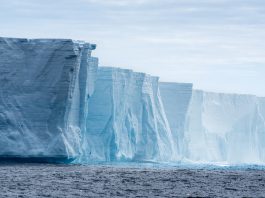Accurately predicting future losses in Arctic Sea ice is set to be significantly enhanced due to the development of an innovative Artificial Intelligence (AI) tool.
The AI system – called IceNet – is the brainchild of a collaborative endeavour between researchers from the British Antarctic Survey (BAS) and The Alan Turing Institute and is proficient in calculating what future Arctic Sea ice conditions will be up to months in advance.
IceNet will provide a plethora of groundbreaking advancements in environment monitoring, enabling scientists to develop precise Arctic Sea ice forecasts that can proficiently predict levels for the season ahead, a measurement that has eluded environmental scientists for decades. In addition to this, the novel AI system may aid in designing the next generation of early-warning systems that will help in protecting and Arctic wildlife and coastal communities from the impacts of Arctic Sea ice loss.
Their research is published in the journal Nature Communications.
The extent of Arctic Sea ice loss
The Arctic Sea ice is a considerably vast sheet of frozen seawater that resides at the North and South poles; however, despite its location being understood, predicting its size and behaviours is incredibly challenging due to the complexity of its relationship with the atmosphere above and ocean below. The Sea ice is very sensitive to ever-increasing temperatures, resulting in the area being reduced by 50% over the last 40 years, which is around the same size as 25 times the areas of Great Britain. This rapid acceleration of destruction to the Arctic Sea ice has and will continue to have dire consequences for the planet’s climate, ecosystems, and indigenous and local communities whose survival and livelihoods depend on the Arctic Sea Ice cycle.
Ensuring efficient forecasts with AI
The IceNet Artificial Intelligence tool provides an accuracy of nearly 95% in predicting how much Arctic Sea ice will be present up to two months in advance, which far exceeds the capabilities of the traditionally used physics-based model.
Lead author Tom Andersson, Data Scientist at the BAS AI Lab and funded by The Alan Turing Institute, said: “The Arctic is a region on the frontline of climate change and has seen substantial warming over the last 40 years. IceNet has the potential to fill an urgent gap in forecasting sea ice for Arctic sustainability efforts and runs thousands of times faster than traditional methods.”
Dr Scott Hosking, Principal Investigator, Co-leader of the BAS AI Lab and Senior Research Fellow at The Alan Turing Institute, commented: “I’m excited to see how AI is making us rethink how we undertake environmental research. Our new sea ice forecasting framework fuses data from satellite sensors with the output of climate models in ways traditional systems simply couldn’t achieve.”
Forecasting systems that are widely utilised attempt to model the laws of the physics directly, whereas IceNet was designed based on a concept called deep learning. Because of this, the IceNet model analyses the behaviours in the sea ice, learning trends in thousands of years of climate simulation data, which it amalgamates with decades of observational data to forecast the extent of the Arctic Sea ice multiple months into the future.
Andersson concluded: “Now we’ve demonstrated that AI can accurately forecast sea ice, our next goal is to develop a daily version of the model and have it running publicly in real-time, just like weather forecasts. This could operate as an early warning system for risks associated with rapid sea ice loss.”









